This Sourdough Semolina Einkorn Bread is made with a sourdough levain, semolina flour and Einkorn flour and baked in a ceramic Dutch Oven.
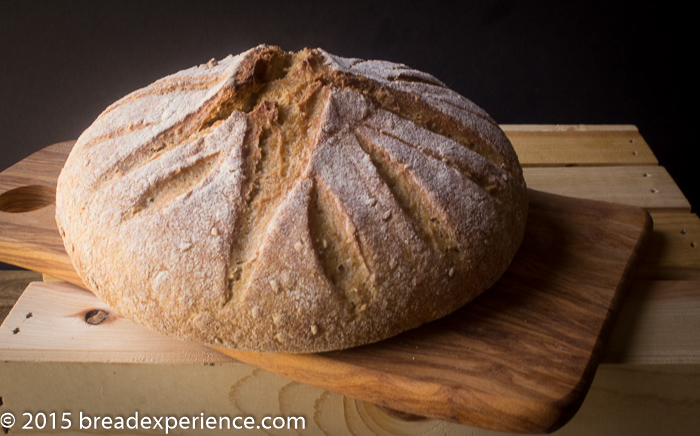
The flavor is rich and nutty due to the inclusion of Einkorn as well as sesame seeds which are sprinkled throughout the dough. The semolina acts as the centerpiece for this loaf, imbuing the loaf with a creamy color and slightly grainy texture which lends itself well for toasting or enjoying warm with butter.
How I used baker’s percentages to create this Sourdough Semolina Einkorn Bread
This bread is an adaptation of one of the loaves from BREAD: a Baker’s Book of Techniques and Recipes by Jeffrey Hamelman.
When adapting the formula, one of my goals was to reduce the amount of dough so that it would fit in my smaller Emile Henry ceramic Dutch oven. To accomplish this, I adjusted the percentages of water and flour. I also introduced a new flour to the mix. I started with 500 grams of flour and instead of using regular bread flour, I substituted all-purpose (80% extraction) Einkorn flour in the levain and whole grain Einkorn in the final mix.
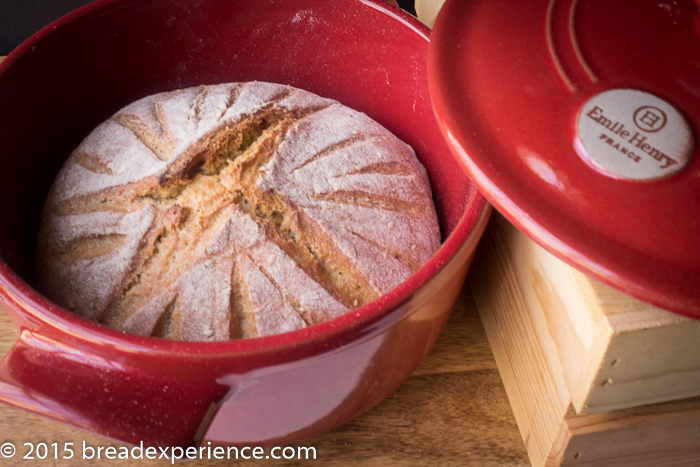
This is the beauty of using baker’s percentages. Once you start weighing the ingredients and approaching bread-making in terms of percentages rather than a list of ingredients, it makes it so easy to transform a loaf into your creation by just changing up the percentages of the components used in the loaf.
This dough was really easy to work with. I started the levain Friday evening and the bread was ready to be baked late afternoon on Saturday. Although this method is a 2-day process, the hands-on time can be modified to fit your schedule. Just adjust the timing based on when you want to serve the bread.
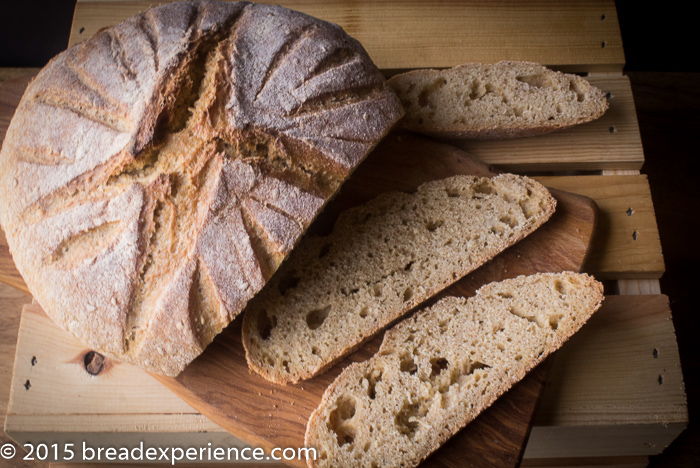
This loaf turned out to be the perfect size for two. It goes well with savory soups, egg and cheese sandwiches, grilled cheese, or warm with butter.
Equipment needed:
- Mixing bowls – large and medium
- Danish dough whisk or large wooden spoon
- Plastic dough scraper or spatula for scraping down the bowl
- Bench knife for scraping counter and lifting dough
- Lined round proofing basket or bowl lined with a kitchen towel
- Bread scoring lame or knife
- Dutch Oven or Bread Cloche
- Cooling rack
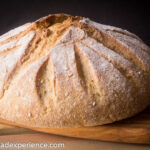
Sourdough Semolina Einkorn Bread for Two
Description
This Sourdough Semolina Einkorn Bread, made with sourdough, semolina flour and Einkorn flour and baked in a ceramic Dutch Oven, has a rich and nutty flavor.
Ingredients
Sourdough Build (15% of the total flour)
- 75 grams / 100% all-purpose Einkorn (or bread flour)
- 94 grams / 125% water
- 15 grams / 20% mature culture (I used my apple starter)
Final Build
- 300 grams Semolina flour (I used Bob’s Red Mill semolina)
- 125 grams whole grain Einkorn flour
- 300 grams water
- 8 grams salt
- 25 grams sesame seeds, additional for sprinkling on top (optional)
Instructions
Day 1: Evening – Start the Liquid Levain
- In a large bowl, prepare the liquid levain 12 to 16 hours before you plan to mix the final dough.
- If your starter hasn’t been fed recently, feed it several hours before you plan to start the final build.
- Cover and let it rest at room temperature (about 70 degrees F.). My house was about 64 degrees F. so I let it rest about 14 hours before it was ready to use.
Day 2: Morning – Mix the Final Dough
- In a separate bowl, whisk together the dry ingredients, including the sesame seeds, and set aside.
- Pour about 200 grams of the water over the starter, and reserve the rest of the water to use as needed. Stir using a Danish dough whisk or wooden spoon to break up the starter.
- Add the dry ingredients to the wet ingredients and stir to combine. When the dough is too heavy to mix by hand, use wet hands to thoroughly incorporate the dough. Add the reserved water as needed until there are no bits of flour and the dough has come together.
Bulk Ferment
- Remove the dough to a floured surface and let it rest for 20 minutes. You can cover the dough with the bowl or plastic wrap during the rest period.
- Fold the dough, then gently shape it into a ball. Place it in a clean, lightly greased bowl and turn to coat with oil.
- Cover and let it bulk proof for 2 hours. Perform 2 folds during the first hour – 1 fold every 30 minutes. Then let the dough rest covered for the final hour.
Final Proof
- Remove the dough to a lightly floured surface and shape into a rough ball. Let rest for 20 minutes.
- Shape the dough into a tighter boule and place seamside up in a heavily-floured, lined banneton proofing basket. I use a mixture of white/rice flour to dust the liners. You can also use a mixture of semolina/white flour.
- Let the loaf proof for 2 hours at about 76 degrees F. or up to 18 hours at about 42 degrees F.
Baking the Loaf
- Preheat the oven to 450 degrees F. for about 45 minutes with a Dutch Oven on the bottom shelf.
- Carefully remove the hot Dutch Oven to a protected workspace (a wooden board or heavy towel)
- Gently flip the loaf onto the bottom of the Dutch Oven and carefully score the loaf using the pattern of your choice. Alternately, omit the scoring and allow the loaf to open up on its own. I happen to like scoring so I usually just score it.
- Transfer the Dutch Oven to the oven using heavy oven mitts and bake the loaf with the lid on for 25-30 minutes. Remove the lid and continue baking an additional 10-15 minutes or until the loaf is brown and crusty on the outside.
- Remove the baker to a protected surface. Then remove the loaf to a wire rack to cool before slicing and serving.
Notes
The original formula utilized a liquid culture (meaning the sourdough is fed with more water than flour). The starter I used is 100% hydration. I didn’t adjust the liquid in the starter or the amount of liquid used in the levain.
I used all-purpose Einkorn in the levain. Einkorn doesn’t soak up water the same as bread flour, but I decided to make any necessary adjustments in the final mix.
For the final mix, I added more water, because whole grain Einkorn soaks up more water although it takes a bit longer for it to absorb it.
If you use regular bread flour in this bread, add the water gradually. You may need more or less depending on the flour used.
Both Einkorn and Semolina perform better when mixed by hand. If you do use a mixer, keep a close watch on the dough so that it doesn’t break down in the mixer.
- Category: Semolina Bread
Happy Baking!
Cathy
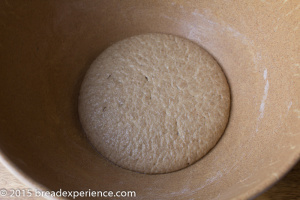
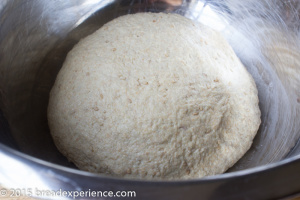
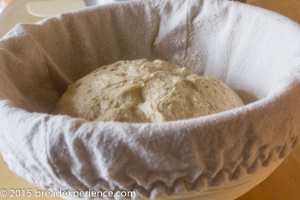
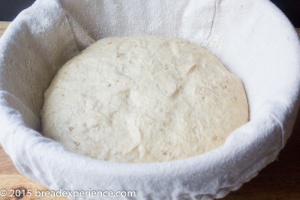
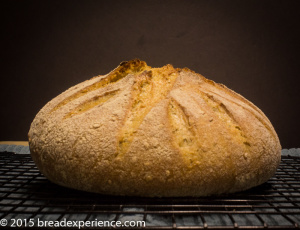
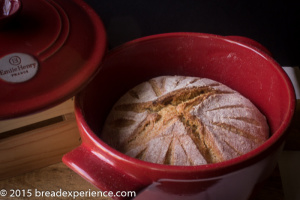
Gordon says
Why do you call this semolina bread if you are using duram? People who don’t know the difference will have completely different results.
Cathy says
Thank you for catching that typo! I definitely used semolina in this loaf, not durum flour. You’re right! Semolina is different from durum flour although they are both milled from durum wheat.
I updated the ingredient list to read – 300 grams Semolina flour (I used Bob’s Red Mill Semolina).